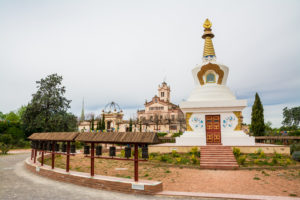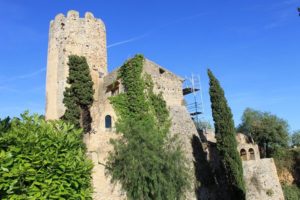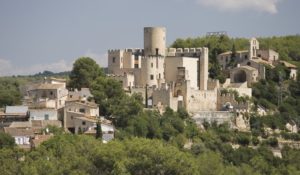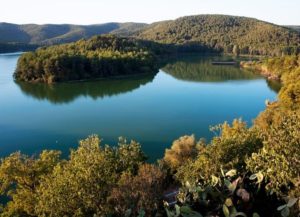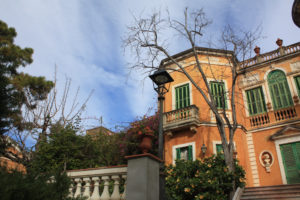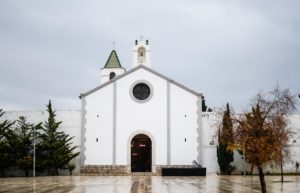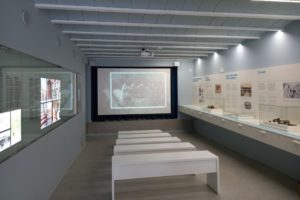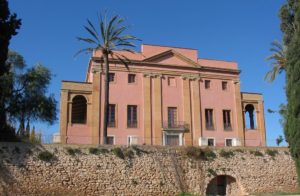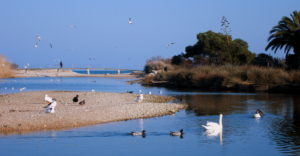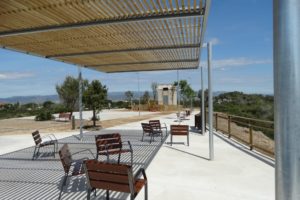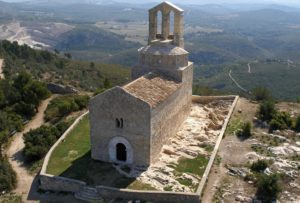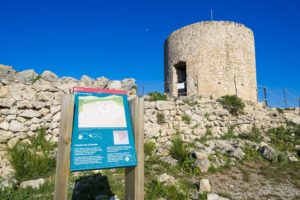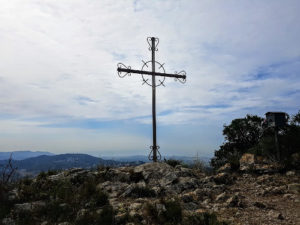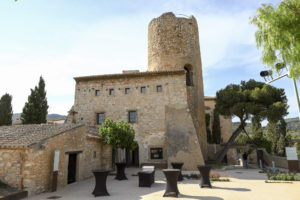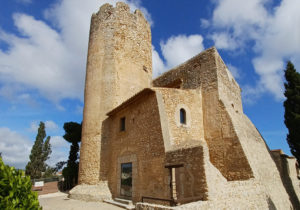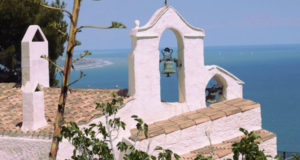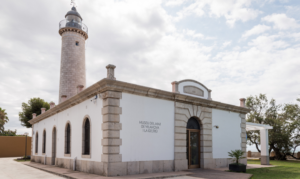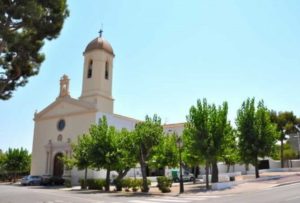Points of interest
Buildings, beaches, monuments, hermitages... it is here that the stories of a town are built. Because the uniqueness of a region is concentrated in its people, customs and traditions, but these happen where things never change.
Come and discover the history of a village, visit the Garraf.
-
Buddhist monastery
The Garraf Monastery, located in the Palau Novella in the Garraf Park, is a unique modernist-style building dating from 1890 and today houses the spiritual home of the Sakya Tashi Ling community. The community founded the monastery in 1996, maintaining and respecting the cultural heritage of the ...
The Garraf Monastery, located in the Palau Novella in the Garraf Park, is a unique modernist-style building dating from 1890 and today houses the spiritual home of the Sakya Tashi Ling community. The community founded the monastery in 1996, maintaining and respecting the cultural heritage of the building and its surroundings.
In addition to the refreshing adventure that can come with a stroll through nature or the spectacular peace of a walk, the Buddhist temple of Garraf Sakya Tashi Ling offers plenty of options and activities, whether you come out of curiosity or if you really want to delve deeper into Buddhism.see more
see less
Find it at: Plana Novella – Jafre – Vallgrassa
-
Canyelles Castle
The village is defined by the monumental ensemble of its castle and church, located on the top of a hill at an altitude of 142m, which can be seen from all the accesses to the municipality. The castle is documented as dating from the 15th century, when it was owned by Franci Terré, Lord of ...
The village is defined by the monumental ensemble of its castle and church, located on the top of a hill at an altitude of 142m, which can be seen from all the accesses to the municipality. The castle is documented as dating from the 15th century, when it was owned by Franci Terré, Lord of Canyelles, but it is hypothesised that it was originally a defence tower for the great bastion of Olèrdola.
The remains that remain from this period consist of a circular tower and a fragment of wall with five battlements. Nowadays, it is a privately owned castle that was rebuilt by the owner himself, and it is currently used by the Town Council for popular activities.
see more
see less
Find it at: Canyelles – Olèrdola – Puig de l’Àliga
-
Castellet
The imposing castle (10th century), now the headquarters of the Abertis Foundation, and located on the north bank of the Foix reservoir, is the starting point for interesting routes to discover the natural wealth of the village.
In June, this setting becomes the setting for an ...The imposing castle (10th century), now the headquarters of the Abertis Foundation, and located on the north bank of the Foix reservoir, is the starting point for interesting routes to discover the natural wealth of the village.
In June, this setting becomes the setting for an authentic mediaeval market, which takes us back to a time when austerity awakened the charms of a privileged landscape.see more
see less
Find it at: Mas de l'Artís - Foix Reservoir - Castellet
-
Foix Reservoir
The Foix reservoir is a Spanish hydroelectric infrastructure built on the Foix river, a short river only 41 km long that rises in the Sierra de la Laguna, located in the region of Noya. This dam is located exactly in the municipality of Castellet i Gornal, in the Alt Penedès region, bordering the ...
The Foix reservoir is a Spanish hydroelectric infrastructure built on the Foix river, a short river only 41 km long that rises in the Sierra de la Laguna, located in the region of Noya. This dam is located exactly in the municipality of Castellet i Gornal, in the Alt Penedès region, bordering the Garraf region, in the province of Barcelona, Catalonia.
It was in the context of the serious agricultural and general economic crisis of the late 19th century that the idea of building the Foix reservoir was born. Such an infrastructure would decisively transform the agriculture of the villages closest to the river Foix, which would switch from vineyards, severely decimated by phylloxera in the 1990s with the consequent fall in the price of wine, to irrigated land.
see more
see less
Find it at: Mas de l'Artís - Foix Reservoir - Castellet
-
Gardens of Can Travé
The Classic Romantic Gardens of Can Travé, located in Cubelles, have an extension of more than 11,400 m² and have an important pine grove, with two citrus groves and a part of rose gardens. They are located in an area of recovery of the historical and artistic heritage of the municipality ...
The Classic Romantic Gardens of Can Travé, located in Cubelles, have an extension of more than 11,400 m² and have an important pine grove, with two citrus groves and a part of rose gardens. They are located in an area of recovery of the historical and artistic heritage of the municipality with a high value of historical memory. The recovery of the gardens and the improvement of lighting and irrigation, make it a space for heritage tourism in the region.
see more
see less
Find it at: Cubelles - Serra de Sant Antoni - Turó de l'Avenc - Puigdetiula / Discovering the mouth of the Foix, "El Foix, oasi de natura" Cubelles
-
Hermitage of Sant Sebastià
The chapel of San Sebastián is a 19th-century religious building in Sitges, in the Garraf, included in the Inventory of the Architectural Heritage of Catalonia.
Although there is no documentation on the origins of the primitive chapel of Saint Sebastian, it is thought to date back ...The chapel of San Sebastián is a 19th-century religious building in Sitges, in the Garraf, included in the Inventory of the Architectural Heritage of Catalonia.
Although there is no documentation on the origins of the primitive chapel of Saint Sebastian, it is thought to date back to the 8th century; the inscription of the year 1614 on its walls has led historians to place some remodelling work at that date. The current building was begun in 1857 (date that appears on the central voussoir of the door).
see more
see less
Find it at: Sitges - Cruz de San Isidro - Ermita de la Trinidad
-
Indianos Interpretation Centre (Sant Pere de Ribes)
The municipality of Sant Pere de Ribes belongs to the Network of Indian municipalities of Catalonia and annually celebrates a festival dedicated to the culture and legacy of all those Tibetans who emigrated to America in the 19th century in search of a better life: "El reton dels Indians", an event ...
The municipality of Sant Pere de Ribes belongs to the Network of Indian municipalities of Catalonia and annually celebrates a festival dedicated to the culture and legacy of all those Tibetans who emigrated to America in the 19th century in search of a better life: "El reton dels Indians", an event that festively spreads the history, culture and gastronomy. It is a facility dedicated to spreading the legacy and heritage of their "American" ancestors.
see more
see less
Find it at: Sant Pere de Ribes – El Montgrós – Font d’en Sidro / Sitges – Sant Pere de Ribes / From Sant Pere de Ribes to Olivella and back / Route Among Vineyards In Sant Pere De Ribes
-
Masia Cabanyes
Located on the outskirts, before the 19th century it was called Masía de Parellada. The Cabanyes family bought it in Parellada in 1790 and in 1798 they had the large neoclassical house built, where the poet Manuel de Cabanyes died.
The Cabanyes family ceded it to the Town Council of ...Located on the outskirts, before the 19th century it was called Masía de Parellada. The Cabanyes family bought it in Parellada in 1790 and in 1798 they had the large neoclassical house built, where the poet Manuel de Cabanyes died.
The Cabanyes family ceded it to the Town Council of Vilanova i la Geltrú in 1975. Since the 1990s it has been in the custody of the Garraf Regional Council, which has helped it with restoration, cataloguing and rehabilitation work, and in 2014 it was declared a Cultural Asset of National Interest by the Generalitat de Catalunya.
It houses the Manuel de Cabanyes Romanticism Interpretation Centre. It offers the service of renting its facilities, an ideal space for cultural and leisure activities, as well as various ceremonies (civil weddings, banquets, meetings...).
see more
see less
Find it at: Vilanova i la Geltrú – Puigmoltó
-
Mouth of Foix
The mouth of the river Foix is located in the municipality of Cubelles, delimited between the beach and the RENFE railway line. In the Natural Area of the Foix Delta you can spend the day outdoors and enjoy the natural environment.
The recovery of the wetlands at the mouth of the ...The mouth of the river Foix is located in the municipality of Cubelles, delimited between the beach and the RENFE railway line. In the Natural Area of the Foix Delta you can spend the day outdoors and enjoy the natural environment.
The recovery of the wetlands at the mouth of the river Foix has made this area one of the most attractive in the municipality. The river Foix - which has been dry for most of the year since the construction of the Foix reservoir - is another of the town's emblematic elements. As well as being able to spend a day in the middle of nature, you can observe the behaviour of the birds native to this area. The space is also aimed at schools, which can visit and study the ecosystem of a Mediterranean river such as the Foix.
see more
see less
Find it at: Cubelles - Serra de Sant Antoni - Turó de l'Avenc - Puigdetiula / Discovering the mouth of the Foix, "El Foix, oasi de natura" Cubelles
-
Olèrdola and Montserrat Park Viewpoint
The construction of the Montserrat Viewpoint is part of the Garraf: paths, heritage and nature regional project, and has been co-financed by the European Regional Development Fund (ERDF). The work began in January and the needs of the residents of Daltmar have been taken into account when defining ...
The construction of the Montserrat Viewpoint is part of the Garraf: paths, heritage and nature regional project, and has been co-financed by the European Regional Development Fund (ERDF). The work began in January and the needs of the residents of Daltmar have been taken into account when defining the project. Their participation and contributions have been taken into account in the design of this space that recovers the sector.
The project has made it possible to completely transform an obsolete and degraded space, formerly used as a road system, into a space for enjoyment that is fully integrated into the Olèrdola Park. Due to its strategic location on the Pic de l'Àliga mountain range, one of the highest points in the territory, the new Montserrat Viewpoint is a great window on the Olèrdola natural park and also on the mountains of Montserrat.
see more
see less
Find it at: Canyelles – Olèrdola – Puig de l’Àliga
-
Olèrdola complex
From the first settlers we have found the remains of a tomb located near the present-day entrance area. The first settlement protected by a wall dates from the beginning of the Iron Age (8th century - beginning of the 6th century BC). Between the 5th-4th and 1st centuries BC, Olèrdola was occupied ...
From the first settlers we have found the remains of a tomb located near the present-day entrance area. The first settlement protected by a wall dates from the beginning of the Iron Age (8th century - beginning of the 6th century BC). Between the 5th-4th and 1st centuries BC, Olèrdola was occupied by the Cessetans, one of the Iberian peoples that occupied the Catalan coastal area. The Iberian oppidum (fortified settlement) was of considerable size (3.5 ha) and its inhabitants settled on the lower part of the rocky platform, adapting the pre-urban structure to the orography of the terrain and taking advantage of the existing wall. To the right of the entrance gate to the enclosure were various craft workshops that operated between the 4th century and the end of the 3rd century BC, including a dyeing and/or tanning factory, the only one documented in the Iberian world.
In 1963 the Diputació de Barcelona acquired the estate. In November 1971, after some alterations to the church and the construction of a new building on the site of a former farmhouse-rectory, the Olèrdola monument complex was opened to the public. In 1995, the monumental complex of Olèrdola became one of the sites of the Archaeology Museum of Catalonia, and since 2014 it has been managed by the Catalan Cultural Heritage Agency. Olèrdola was declared a Cultural Asset of National Interest in 1931 and an Asset of Cultural Interest (BIC).
see more
see less
Find it at: Canyelles – Olèrdola – Puig de l’Àliga
-
Olivella old castle
The Castell Vell de Olivella is an ancient castle, declared a cultural asset of national interest, documented since 992. Nowadays, only some remains of the walls are preserved, which seem to outline a trapezoidal plan.
In the midst of the rubble of Olivella castle, and taking ...The Castell Vell de Olivella is an ancient castle, declared a cultural asset of national interest, documented since 992. Nowadays, only some remains of the walls are preserved, which seem to outline a trapezoidal plan.
In the midst of the rubble of Olivella castle, and taking advantage of its stones, a mill was built in the 18th century, on the initiative of the parish priest of Olivella, which remained unfinished; a round tower can be seen.
Very close to Olivella castle are the remains of the old Romanesque chapel of Sant Pere, the church was the old parish church of Olivella.
see more
see less
Find it at: Olivella - Old Castle of Olivella / From Sant Pere de Ribes to Olivella and back / Olivella Castle Route
-
Puig de l'àliga
At the crossroads of carrer Major and Balsa de Llot de Canyelles, start the route along the path that goes up the Pla del Bosc stream, marked with a flag. Pass through the Cogullada and Daltmar housing estates to head first towards the Olèrdola complex and then towards Puig de l'Àliga, following ...
At the crossroads of carrer Major and Balsa de Llot de Canyelles, start the route along the path that goes up the Pla del Bosc stream, marked with a flag. Pass through the Cogullada and Daltmar housing estates to head first towards the Olèrdola complex and then towards Puig de l'Àliga, following the signs on the ridge and the GR 92.3 continuity markers. The return to Canyelles is along a connecting path on the right (southeast) about 200m down from Puig de l'Àliga.
see more
see less
Find it at: Canyelles – Olèrdola – Puig de l’Àliga / Puig de l'Àliga panoramic route
-
Ribes Castle
The tower of Ribes Castle is one of the icons of the municipality of Sant Pere de Ribes. It also represents the mythical origin of the town, documented as early as 990 as the castle of Bell-lloc or Ribes. Over the centuries, the castle passed through the hands of feudal lords, ecclesiastical powers ...
The tower of Ribes Castle is one of the icons of the municipality of Sant Pere de Ribes. It also represents the mythical origin of the town, documented as early as 990 as the castle of Bell-lloc or Ribes. Over the centuries, the castle passed through the hands of feudal lords, ecclesiastical powers and the Ribes family... until 1620, when it was ceded to the municipal commons.
The castle of Ribes (or Bell-Lloc) has been classified since 1949 as a Cultural Asset of National Interest (BCIN). Standing on a small hill, the tower of the castle of Ribes (almost 20 metres high and 7 metres in diameter) presides over the old village of Sota-Ribes, the stream and the timba. It is surrounded by agaves, gorse and cypresses. Further down, the pines of the lever bridge pay vows of vassalage to it.
see more
see less
Find it at: Sant Pere de Ribes – El Montgrós – Font d’en Sidro / Route Among Vineyards In Sant Pere De Ribes
-
Sant Sebastià Beach
Sant Sebastià beach is one of the most popular beaches in Sitges. It is a beach frequented by families thanks to its shallow, clear waters where children can play freely. Located in the centre of the town and in an old seaside neighbourhood, this beach has all the services for holidaymakers, ...
Sant Sebastià beach is one of the most popular beaches in Sitges. It is a beach frequented by families thanks to its shallow, clear waters where children can play freely. Located in the centre of the town and in an old seaside neighbourhood, this beach has all the services for holidaymakers, including disabled access. You can also stroll along the seafront promenade, which is full of terraces and sea views.
see more
see less
Find it at: Sitges - Cruz de San Isidro - Ermita de la Trinidad
-
Sota Ribes Castle
The oldest settlement in Ribes is in Sota-ribes, a small settlement built on a hill overlooking the confluence of the Espluga stream and the Ribes stream. In the highest part of the village is Ribes Castle, built in the High Middle Ages. Opposite it was a castle chapel that was completely renovated ...
The oldest settlement in Ribes is in Sota-ribes, a small settlement built on a hill overlooking the confluence of the Espluga stream and the Ribes stream. In the highest part of the village is Ribes Castle, built in the High Middle Ages. Opposite it was a castle chapel that was completely renovated in the 17th century to become the church of Sant Pere.
In front of the church stands the old rectory, next to which a paved path descends to the centre itself, which is crossed by the stream. Here we find the Casa del Terme, an old building of the Comú de Ribes documented from the 15th century. In the surrounding area there are several stone houses with openings made of worked stone.
see more
see less
Find it at: Sant Pere de Ribes – El Montgrós – Font d’en Sidro / Vilanova i la Geltrú – Puigmoltó / Route Among Vineyards In Sant Pere De Ribes
-
Trinity Chapel
The Trinity Chapel, located in the middle of the Garraf Park with the sea as a backdrop and covered in white with modernist details, this chapel is the perfect gift for one of the best family hiking routes that can be done in Silos.
It is an ancient hermitage, with documentary ...The Trinity Chapel, located in the middle of the Garraf Park with the sea as a backdrop and covered in white with modernist details, this chapel is the perfect gift for one of the best family hiking routes that can be done in Silos.
It is an ancient hermitage, with documentary evidence dating back to 1375. With popular architecture and protected as an Asset of Local Interest, the setting makes it unique. In fact, it is how children (and many adults) would draw a church: on top of a mountain, small, white and with views of the sea. And to complete the spectacle, the entrance façade is clad in stone and arches.
see more
see less
Find it at: Sitges - Cruz de San Isidro - Ermita de la Trinidad / Castellot Garraf Itinerary
-
Vilanova Lighthouse
Also known as the San Cristóbal lighthouse, so called because of the point where it stands, it is located behind the "Farola" beach. In the same place there was previously, in 1866, another smaller lighthouse, which fell into disuse due to its short range in 1905, when this new, higher ...
Also known as the San Cristóbal lighthouse, so called because of the point where it stands, it is located behind the "Farola" beach. In the same place there was previously, in 1866, another smaller lighthouse, which fell into disuse due to its short range in 1905, when this new, higher tower was inaugurated, raising the light from 12.6 to 21 metres at present.
The present lighthouse consists of a square building with a porch facing the sea and an external tower, topped by a silver dome, attached to the side wall. In addition to its function as a guide, since 1981 it has housed the collection of the Museum of the Sea.
see more
see less
Find it at: Vilanova - Miralpeix Castle - Sant Pere de Ribes / Punta Grossa Viewpoint Route
-
Vinyet Hermitage
The sanctuary of Our Lady of Vinyet is a religious building currently integrated in the urbanised area of Vinyet in the municipality of Sitges and included in the Inventory of the Architectural Heritage of Catalonia.
The feast day of Our Lady of Vinyet is 5 August. Masses are held in ...The sanctuary of Our Lady of Vinyet is a religious building currently integrated in the urbanised area of Vinyet in the municipality of Sitges and included in the Inventory of the Architectural Heritage of Catalonia.
The feast day of Our Lady of Vinyet is 5 August. Masses are held in honour of the Virgin Mary and there are different events on the same day. In the past, the day was a public holiday in Sitges and the inhabitants of the surrounding villages even went to spend the afternoon at the fair that was held around the hermitage. The day ends with the launching of a small firework display. Although nowadays it is no longer a public holiday, the fact that the celebration takes place in August means that the inhabitants of Sitges and holidaymakers continue to attend.
see more
see less
Find it at: Sitges – Sant Pere de Ribes
